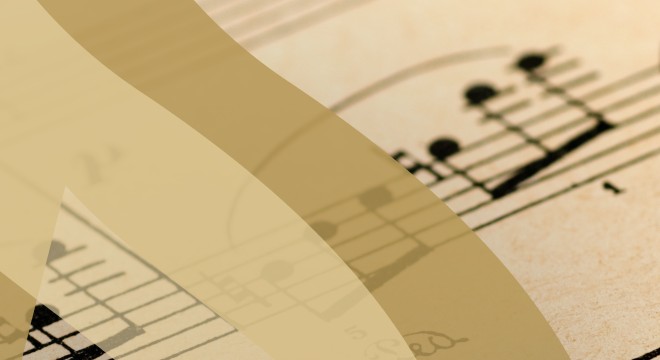Overture in C Major
Fanny Mendelssohn-Hensel was a gifted performer and prodigious composer who created nearly 500 compositions. She was Felix Mendelssohn's older sister. The two were very close and Felix considered Fanny to be both his dearest friend and devoted confidante. Fanny received pretty much the same musical education as Felix and was also a formidable musical talent. In fact, her piano skills were known to be even stronger than her older brother's. Of course, the 19th century was not very welcoming to women who excelled in the arts, but Fanny was able to forge a fine reputation through "salon" performances of her works, especially her compositions for piano. She also pursued conducting and had the opportunity to lead the premiere performance of her brother's well-known Reformation Symphony (#5) in 1830.
Although Fanny wrote several oratorios (choral/orchestral works), Overture in C major is her only purely orchestral composition. It follows the traditional form of early 19th century overtures, including the usual slow introduction. In the central part of the introduction, short motivic ideas are presented in contrasting dynamics before a return of the opening section. A brief flute solo leads to a lively string flourish (Allegro di molto) followed by a series of fanfares for brass and timpani, which serve as preparation for the main body of the overture (Con fuoco).
The "allegro" section of the overture is in traditional sonata-allegro form. We begin with the Exposition: the robust "A" theme, a brief transition, the lyrical "B" theme in the dominant key, and the festive closing theme. Without a clear cadence, the music launches into the "Development" (listen for a sudden shift to the minor mode). Melodic ideas from the exposition are presented in a variety of new key areas, including dramatic diminished chords and varying dynamics. Finally, the music returns "home" for a full Recapitulation of previous themes before commencing the exhilarating "Coda," which employs festive fanfares and flourishes.
Many of the melodic ideas of the piece are crafted from scalar figures. Strings provide energy and drama with ample measured 16ths. Elegant passages in woodwinds and strings provide beautiful contrasts. There is a pervasive sense of familiarity with continuous repetition of musical ideas presented in the early portion of the piece, and there is a wonderful feeling of formal balance from start to finish.
It's unfortunate Fanny Mendelssohn-Hensel wasn't given a platform to share her exquisite music more widely during her lifetime, but it's encouraging that this and many other of her works have more recently come to light. We're pleased to share her wonderful overture to open the program.
Symphony No. 9 in C major, K. 73
When I was a young boy, I remember being introduced to the music of Mozart and hearing about his uncanny ability to compose music as easily as most of us do the simplest of tasks. A child prodigy, Mozart began composing at a very young age, creating music with amazing speed and accuracy. As he got older and more experienced, he was known to conceive music in his head while on walks, returning home to write his new creation in one short sitting. Even more impressive, there are anecdotes that suggest Mozart would attend a piece of music he'd never heard and--after only one hearing--return home to write the entire work down from beginning to end! Mozart was a musical genius with astounding skills and artistic achievements, especially for one who only reached the age of 35. Imagine what he might have accomplished had he lived into his 70s or 80s.
The purpose of programming one of Mozart's early symphonies, which most audiences haven't heard, is to compare the young Mozart with the master who composed the magnificent Requiem, which was his final work. Mozart composed his first symphony when he was only eight years old. Five years later, he'd already written multiple new pieces, including his ninth symphony, an energetic and witty piece that showcases a genius in the making. This miniature symphony lasts only 12 minutes, but it is a model of typical late 18th century Classical style characteristics featuring balanced phrases and clear formal structures.
The first movement features a robust main theme that often outlines triads and is contrasted with elegant suspension figures. This idea of quick juxtapositions of the energetic with the sublime is a common characteristic of many of his future works. The usual development section after the exposition is very brief while the recapitulation is both surprising and inventive with many harmonic twists and turns. Mozart's emerging gift for melody, especially in the beautifully elegant flute writing in the slow, second movement, is evident. The third movement is the usual minuet and trio, the latter quite short and in the unusual subdominant key. Mozart's humor and fun-loving spirit is showcased in the last movement, which is particularly witty and delightful.
Mozart's Symphony No. 9 provides a snapshot of Mozart's youthful energy and formidable skill. In addition to his celebrated tours throughout Europe displaying his virtuoso piano skills, the wunderkind wrote dozens of new works that would be overshadowed by what would come later—hence the lack of performances of works such as Symphony No. 9. Although it would take some years for Mozart to achieve the profound depth and mastery exhibited in his later symphonies, concertos and operas, we hope you enjoy feasting on this opportunity to hear one of his remarkable early works and enjoy comparing it with his incredible Requiem, composed 21-years-later. just before his death at the age of 35.
Requiem in D minor, K. 626
In July 1791, five months before Mozart died, a stranger appeared at his door with a request to commission a Requiem Mass for a "secret commissioner" in honor of his wife who had recently died. Although there are many theories and wild stories about the events surrounding the creation of this incredible work, including the ones presented in the popular movie, Amadeus, scholars agree that the person who commissioned the Requiem was Count Franz von Walsegg-Stuppach. The Count, an amateur musician, wanted to perform the new Requiem Mass every year in his wife's honor. Like many wealthy musicians during those times, it was commonplace to commission new works from gifted composers with the intention of presenting the works as their own. At the time, Mozart had a very full plate, but his difficult financial situation compelled him to take this on, happy to receive half the fee up front. It's amazing to think that one of the most gifted musicians on the planet had such a difficult time making ends meet, but this was often the case with Mozart and with many other 18th century composers.
1791 was a very productive year for Mozart. He wrote two operas—La clemenza di Tito and the incredible Magic Flute—plus his Clarinet Concerto. He also composed a number of small instrumental works. Adding this huge sacred choral/orchestral work to his list of projects was a stretch, especially considering that he was in poor health. Worried he was dying, Mozart was spooked about writing a Mass for the Dead. Soon after his death, the newspaper in his hometown of Salzburg published an article stating that he composed “often with tears in his eyes, constantly saying ‘I fear that I am writing a Requiem for myself.’”
He composed as much of the work as he could, but was unable to recover from his illness. He died on December 5, 1791 at the age of 35 with much of his Requiem incomplete. Mozart was able to finish most of the choral and solo vocal parts, but many of the orchestral parts were left only in sketch form and not yet orchestrated. He was unable to compose any music for the final movements—the Sanctus, Benedictus and Agnus Dei.
One of Mozart's trusted students, the 25-year-old Franz Süssmayr, was given the responsibility of completing the work. It is likely that Mozart was able to convey many of his musical intentions to Süssmayr before he died and most agree that Süssmayr did splendid work, staying true to Mozart's compositional style and bringing this mammoth project to fruition with love and care in honor of his beloved mentor.
Mozart's Requiem begins with the Introitus, featuring gentle, lonely sounds from the bassoons and clarinets. This movement is a slow-moving prayer for the dead: "Grant them eternal rest, Lord, and let perpetual light shine on them." It doesn't take long before we hear a frightful, forte choral statement, which doesn't seem to offer the comfort one might expect in a mass for the dead. Adding to the unsettling character, the orchestration features many syncopated, offbeat rhythms. In the central section, the solo soprano offers praise to God, and the movement closes with many of the musical ideas with which it began. The Introitus ends inconclusively on a half cadence before continuing with the Kyrie ("Lord have mercy, Christ have mercy"), a powerful double fugue creating wonderful counterpoint that recalls the Baroque and J.S. Bach and features some of the most challenging vocal writing of the entire work.
The third part of the Requiem is the Sequence, which is further divided into six subsections. The first of these is the Dies Irae ("Day of Wrath"), which musically represents the judgement day with all the fire and drama one might expect with this text. The next section is Tuba Mirum ("The Trumpet will send its wondrous sound."). Rather than a trumpet, Mozart features the deeper sound of solo trombone. Solos enter from lowest to highest voices: bass, tenor, alto and finally soprano.
Following Tuba Mirum is the Rex Tremendae, honoring the "majestic King" who saves those who are worthy. The persistent dotted rhythms lend noble majesty to the music. This leads directly to the fourth section, Recordare ("Remember kind Jesus... my salvation caused your suffering; do not forsake me on that day."). This lengthy section, in contrast with earlier ones, features solo singers. Mozart musically paints intimacy, earnestness and humility. The frequently descending passages may be reminiscent of tears.
Next, we encounter the more intense Confutatis, which is not unlike the way we began the Sequence (Dies Irae). "When the accused are confounded and doomed to the flames of woe, call me among the blessed." The persistent and driving rhythms in strings alternates with prayerful moments ("I kneel with submissive heart...").
One of the most memorable moments in the Requiem concludes the Sequence: the Lacrimosa ("That day of tears and mourning... spare us by your mercy, Lord."). The poignant, offbeat violin parts are brilliantly conceived, providing exquisite tenderness and beauty to the rendering of the text.
The fourth movement of the Requiem, the Offertory, is in two sections: Domine Jesu ("Lord, Jesus Christ, King of Glory, liberate the souls of the faithful.") and Hostias ("Sacrifices and prayers of praise, we offer to You."). In Domine Jesu, the dynamics are generally soft, but several loud outbursts declare praise to God and make passionate pleas for deliverance from the "lion's mouth!" A short solo section leads to a brilliant fugue for the chorus supported by a lively, rhythmic presence in the orchestra. The Domine Jesu ends on a positive note, changing from G minor to G major, and leads to the beautifully lyrical and prayerful Hostias. The end of Hostias brings back the fugue from Domine Jesu to round out the Offertory.
Finally, we encounter the three concluding sections of the Requiem (Sanctus, Benedictus and Agnus Dei), which Mozart couldn't bring to fruition because of his untimely death. As mentioned earlier, Mozart's talented pupil and good friend, Franz Süssmayr, faithfully completed these sections doing his best to honor what he believed were Mozart's intentions.
The relatively short Sanctus begins with a festive statement ("Holy, Lord God of Hosts, heaven and earth are full of your glory.") followed by a short, energetic fugue (“Hosanna in the Highest!”).
Featuring the quartet of solo singers, the Benedictus is gently lilting and elegant, based on the text "Blessed is He who comes in the name of the Lord." It concludes with a repetition of the short fugue from the end of the Sanctus.
Finally, we come to the last movement of the Requiem, the Agnus Dei ("Lamb of God, who takes away the sins of the world, grant them everlasting rest.") The music opens with a sense of hypnotic pleading. After a short interlude for soprano solo ("May eternal light shine on them."), the choir emphasizes that same text before launching into the identical music from the first movement's Kyrie, this time on a new text ("Grant them eternal rest."). This is the most complex of Mozart's many impressive fugues and it provides a compelling bookend effect for this final, glorious work from one of the most celebrated composers of all time.











.png)
